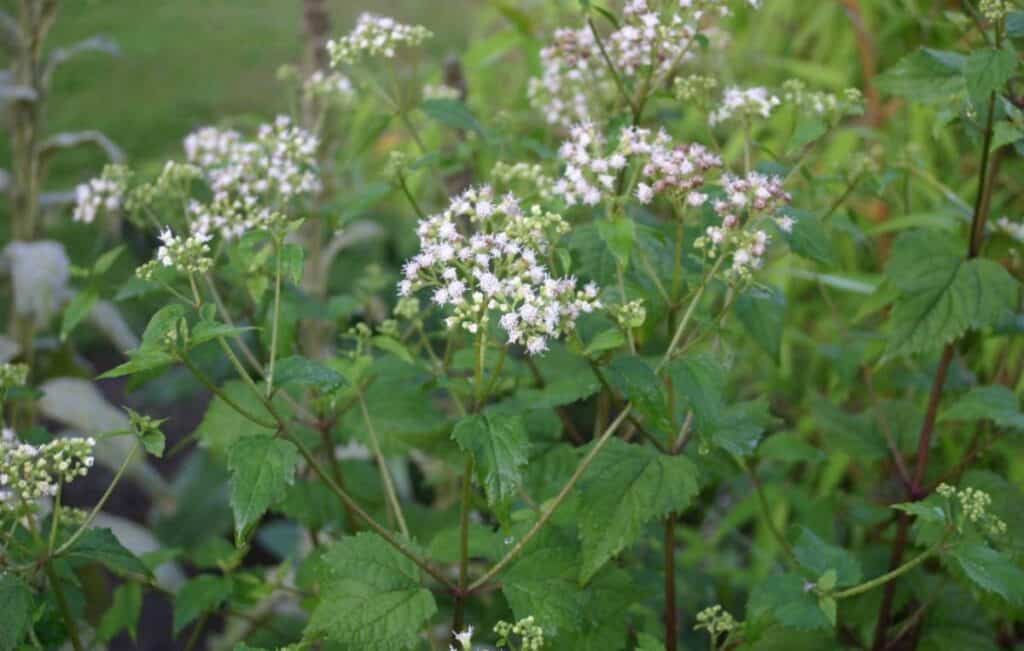I know I’ve talked about this already but growing up on hiking trails and in campsites, there were only a few rules that we had to worry about. A crucial one was don’t touch anything! You don’t mess with Mother Nature, and she won’t mess with you.
So, you’d think that with a name like white snakeroot people would be avoiding this particular plant. I know I would – then again, I’m not particularly keen on anything with ‘snake’ in the name.

Is white snakeroot poisonous? Yes, the leaves and stem of white snakeroot contain tremetol. Tremetol is accumulative and is toxic to both humans and animals; the toxin causes irregular heartbeat, muscular degeneration (of the heart), loss of coordination, and tremors.
Symptoms can take a few days to be detected which makes treatment a bit tricky but if treated early enough human patients can recover. If left untreated, the symptoms will worsen and the patient will die.
What is White Snakeroot?
White snakeroot is a poisonous herb found in the eastern and central parts of North America. Plants can grow upwards to a height of 1.5 meters, and usually you don’t see them until they’ve spread throughout most of your garden.
They typically bloom with white flowers in mid to late summer and fall. It’s a highly adaptive species of plant and can be found in woodlands, shady ground, hedgerows and other similar biomes.
Certain bugs use white snakeroot as a food source; foraging as much as they can in the fall before the weather turns for the winter months.
It makes a nice addition – visually speaking – to a garden, although, if you’ve got pets and/or children it’s probably not something you want in your garden per se.
A Brief History of White Snakeroot
White snakeroot has a rather… colorful history which goes back to the 19th Century in the USA.
European settlers were unfamiliar with white snakeroot, and allowed their livestock to eat it. The tremetol content of the plant poisoned the animals and tainted the cow’s milk.
The Native American tribes who used the plant tried to help out but they were largely ignored. Eventually, a Shawnee medicine woman taught a frontier doctor, Anna Hobbs-Bixby, about white snakeroot and Bixby was able to help control the problem.
Her role in dealing with the white snakeroot problem was also ignored (because of course it was) until years later.
Tremetol Poisoning – White Snakeroot is NOT Edible
The leaves and stems of white snakeroot contains tremetol which is toxic to both animals and humans. It’s an accumulative toxin which means that it’ll take time to build to toxic levels. The toxin affects the heart and causes muscular degeneration, loss of coordination, tremors, irregular heart rate. These symptoms can take a few days to become visible which makes this particularly dangerous.
If detected early, you can treat them if not, the symptoms will worsen, and the poisoned individual will succumb.
Tremetol poisoning is caused/contracted via consumption of contaminated milk/meat. The poison ends up in the stomachs of whatever livestock eats the snakeroot and the resulting meat and/or milk also has tremetol in it.
Anyone who consumes the meat or milk of these animals subsequently becomes ill with what’s called ‘milk sickness’ – in reference to the fact that the poison is in the meat and milk of an animal.
In Conclusion
Milk sickness is rare nowadays as when it comes to commercially available milk, it’s not milk from one cow.
Milk from many different cows have been mixed together; this reduces the tremetol content to a harmless level – unless you’re lactose intolerant, but then you wouldn’t be buying milk, would you?
Still, it’s best not to tempt fate; if you find this plant in your garden, it’s probably a good idea to remove it – all of it – as best you can.
As always, I hope you all enjoyed reading this article and that you found it interesting and informative.

Greg is a South African farmer and homesteader who’s been around animals ever since he can remember. He’s also an avid camper and hiker.

What about touching this? And how do I remove it from around my trash can end in my yard against my fence?? I’m auto immune and elderly.